What is a solar panel?
Solar panel electricity systems, also known as solar photovoltaics (PV), capture the sunâs energy (photons) and convert it into electricity. PV cells are made from layers of semiconducting material, and produce an electric field across the layers when exposed to sunlight. When light reaches the cell, some of it is absorbed into the semiconducting material and causes electrons to break loose and flow. This flow of electrons is an electric current, that can be drawn out and used for powering outside devices. This current, along with the cellâs voltage (a result of built-in electric fields), define the power that the solar cell is capable of producing. It is worth mentioning that a PV cell can produce electricity without direct sunlight, but more sunshine equals more electricity.
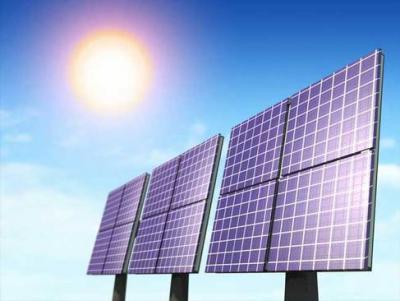
A module, or panel, is a group of cells connected electrically and packaged together. several panels can also form an array, which can provide more electricity and be used for powering larger instruments and devices.
Different kinds of Solar cells
Solar cells are roughly divided into three categories: Monocrystalline, Polycrystalline and Thin Film. Most of the worldâs PVs are based on a variation of silicon. The purity of the silicon, or the more perfectly aligned silicon molecules are, affects how good it will be at converting solar energy. Monocrystalline solar cells (Mono-Si, or single-crystal-Si) go through a process of cutting cylindrical ingots to make silicon wafers, which gives the panels their characteristic look. They have external even coloring that suggests high-purity silicon, thus having the highest efficiency rates (typically 15-20%). They are also space efficient (their efficiency allows them to be small) and live longer than other kinds of solar panels. Alas, they are more expensive than other kinds and tend to be damaged by external dirt or snow.
Polycrystalline silicon (p-Si or mc-Si) solar cells do not go through the abovementioned process, and so are simpler and cost less than Monocrystalline ones. Their typical efficiency is 13-16%, due to lower silicon purity. They are also bigger and take up more space.
Thin-Film solar cells (TFSC), are made by depositing one or several thin layers of photovoltaic material onto a substrate. Different types of TFSCs are categorized by which photovoltaic material is deposited onto the substrate: Amorphous silicon (a-Si), cadmium telluride (CdTe), copper indium gallium selenide (CIS/CIGS), polymer solar panels and organic photovoltaic cells (OPC). Thin-film modules have reached efficiencies of 7-13%. Their mass production is simple, they can be made flexible and are potentially cheaper to manufacture than crystalline-based solar cells. They do, however, take up a lot of space (hampering their use in residential applications) and tend to degrade faster than crystalline solar panels.
Solar power advantages and disadvantages
Solar power is free and infinite, and solar energy use indeed has major advantages. It is an eco-friendly, sustainable way of energy production. Solar energy systems today are also much cheaper than they were 20 years ago, and save money in electricity expenses. In addition, it is a much environmentally cleaner form of energy production that helps reduce global warming and coal pollution. It does not waste water like coal and nuclear power plants and is also considered to be a form of energy that is much safer for use.
Although solar power production is widely considered to be a positive thing, some downsides require mentioning. The initial cost of purchasing and installing solar panels can be substantial, despite widespread government subsidy programs and tax initiatives. Sun exposure is critical and so location plays a significant role in the generation of electricity. Areas that are cloudy or foggy for long periods of time will produce much less electricity. Other commonly argues disadvantages regard insufficiency of produced electricity and reliability issues.
Solar power applications
Common solar energy applications include various residential uses such as solar lighting, heating and ventilation systems. Many small appliances utilize solar energy for operation, like calculators, scales, toys and more. Agriculture and horticulture also employ solar energy for the operation of different aids like water pumps and crop drying machines. The field of transportation has been interested in solar powered vehicles for many years, including cars, planes and boats that are vigorously researched and developed. Solar energy also has various industrial applications, ranging from powering remote locations as well as space and satellite systems, to powering transportation signals, lighthouses, offshore navigation systems and many more.
Solar technologies are vigorously researched, aiming to lower costs and improve existing products as well as integrate PV systems in innovative products like PV-powered curtains, clothes and laptop cases.
Graphene and solar panels
Graphene is made of a single layer of carbon atoms that are bonded together in a repeating pattern of hexagons. It is a 2 dimensional material with amazing characteristics, which grant it the title âwonder materialâ. It is extremely strong and almost entirely transparent and also astonishingly conductive and flexible. Graphene is made of carbon, which is abundant, and can be a relatively inexpensive material. Graphene has a seemingly endless potential for improving existing products as well as inspiring new ones.
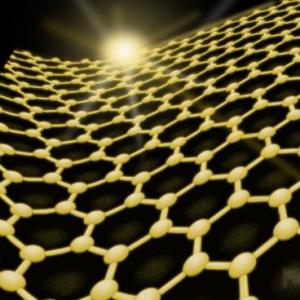
Solar cells require materials that are conductive and allow light to get through, thus benefiting from graphene's superb conductivity and transparency. Graphene is indeed a great conductor, but it is not very good at collecting the electrical current produced inside the solar cell. Hence, researchers are looking for appropriate ways to modify graphene for this purpose. Graphene Oxide (GO), for example, is less conductive but more transparent and a better charge collector which can be useful for solar panels.
The conductive Indium Tin Oxide (ITO) is used with a non-conductive glass layer as the transparent electrodes in most organic solar panels to achieve these goals, but ITO is rare, brittle and makes solar panels expensive. Many researches focus on graphene as a replacement for ITO in transparent electrodes of OPVs. Others search for ways of utilizing graphene in improving overall performance of photovoltaic devices, mainly OPVs, as well as in electrodes, active layers, interfacial layers and electron acceptors.
Commercialization efforts
While graphene-based solar cells are not currently commercially available, some efforts are bearing fruit in regards to the use of graphene in auxiliary aspects of PV. One such example is ZNShine Solar's G12 evolution era series - comprised of a 12-busbar graphene module, 5-busbar graphene module and double-glass graphene module. According to reports, the application of ZS's graphene film layer increases light transmission performance of the glass itself. In addition, Znshine Solar's modules are self-cleaning. In July 2018, ZNShine Solar won the bid to provide 37.5MW of PV modules to Bharat Heavy Electricals Limited (BHEL), India's largest power generation equipment manufacturer. According to the contract, 10% of the shipment will be graphene-coated solar panels. In June 2019, Znshine Solar announced signing a 100MW graphene-enhanced solar module supply agreement with UAE's Etihad Energy services.
Further reading
The latest graphene solar news:
Graphene coating could help create higher energy density lithium-ion batteries
Researchers at Northwestern University and Clemson University in the U.S, along with researchers from Sejong University in Korea, have examined the origins of degradation in high energy density LIB cathode materials and developed graphene-based strategies for mitigating those degradation mechanisms and improving LIB performance.
Their research could be valuable for many emerging applications, particularly electric vehicles and grid-level energy storage for renewable energy sources, such as wind and solar.
Researchers examine novel inkjet-printed graphene for high‐quality large‐area electronics
Researchers from the University of Nottingham’s Centre for Additive Manufacturing (CfAM) have reported a breakthrough in the study of 3D printing electronic devices with graphene.
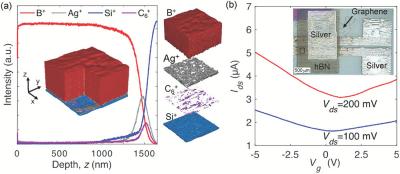 Characterization of the fully inkjetâprinted graphene/hBN FET. Photo from article
Characterization of the fully inkjetâprinted graphene/hBN FET. Photo from article
The scientists utilized an inkjet-based 3D printing technique to deposit inks that contained flakes of graphene, in a promising step towards replacing single-layer graphene as a contact material for 2D metal semiconductors.
WMG and Senergy Innovations develop graphene-enabled all polymer solar thermal cell
Researchers led by Professor Tony McNally, from WMG, at the University of Warwick, in partnership with Senergy Innovations, have launched the first nanomaterial enabled all polymer solar thermal cell. This achievement was supported by funding from BEIS (Department for Business, Energy & Industrial Strategy).
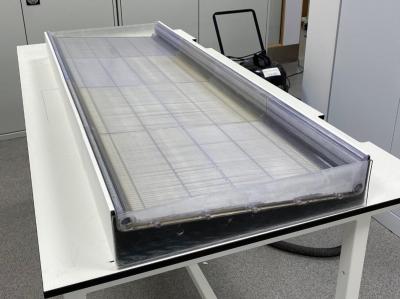
The thermal properties of the polymers that were used were modified to enable heat from sunlight to be transferred with high efficiency to heat water in a low cost and sustainable way. The modular design of the cells reportedly allows for the rapid construction of a solar thermal cell array on both domestic and industry roofing.
Graphene-perovskite solar farm trial up and running in Greece
An experimental graphene-based perovskite solar farm has been operating in Greece for several months, and early results are said to be very promising when it comes to power output and efficiency.
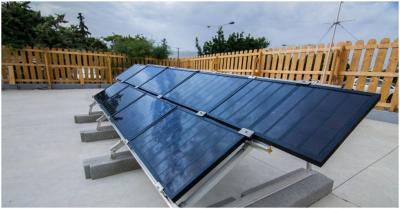
Located at the Hellenic Mediterranean University in Crete and spearheaded by the EU’s Graphene Flagship, the new solar farm consists of nine grapheneperovskite panels with a total area of 4.5m2 and a total output of approximately 261 watt-peak (Wp).
MIT team reports new roll-to-roll process for production of large sheets of high-quality graphene
Researchers at MIT have developed a new roll-to-roll production process for large sheets of high-quality graphene, which the team says could lead to ultra-lightweight, flexible solar cells, and to new classes of light-emitting devices and other thin-film electronics.
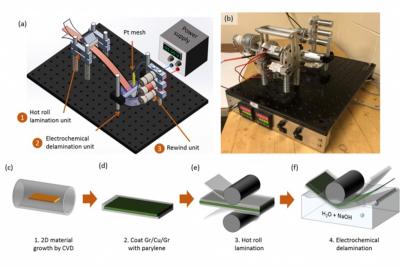
The new manufacturing process, which the team says should be relatively easy to scale up for industrial production, involves an intermediate buffer layer of material that is key to the technique’s success. The buffer allows the ultrathin graphene sheet, less than a nanometer (billionth of a meter) thick, to be easily lifted off from its substrate, allowing for rapid roll-to-roll manufacturing.
Researchers develop a graphene metamaterial film that absorbs sunlight with minimal heat loss
Researchers from Swinburne University developed a graphene-based highly efficient solar absorbing film that absorbs sunlight with minimal heat loss. The film rapidly heats up in an open environment and has great potential in solar thermal energy harvesting systems - in addition to other applications such as thermophotovoltaics (directly converting heat to electricity), solar seawater desalination, light emitters and photodetectors.
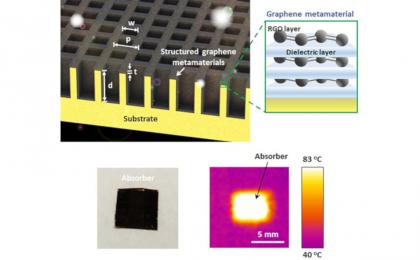
This is the 2nd-generation material developed by the same group - now with a thickness of only 30 nm and improved performance and longer lifetime. The researchers have now created a first prototype and also suggest a scalable low-cost manufacturing process.
Verditek raises over USD$660,000 in share issue
Verditek, developer of lightweight solar panels in Italy, recently raised GBP 505,750 (USD 663,600/EUR 578,219) before expenses, which it plans to use mainly to fund commercial opportunities announced earlier this year. Some of the proceeds will go towards the joint development program with Paragraf, under which the two are working on a silicon/graphene integrated solar cell.
Earlier this year, the Company announced framework, distribution and collaboration agreements and a number of trials with companies it described as big players in their respective markets.
Graphene helps in creating efficient tandem perovskite solar cell
Italian researchers from two Italian institutions have used graphene to develop a perovskite-silicon solar cell - a promising new solar technology - with an impressive conversion efficiency of 26.3%.
The researchers added graphene to the titanium dioxide electron selective layer used in a perovskite solar cell in order to increase chemical stability. The two-terminal cell was made by stacking two sub-cells which were fabricated and optimized separately. The new device blends the advantages of thin-film perovskite and silicon-based heterojunction cells, according to its developers.
New Graphene Flagship "Spearhead Projects" get €92 million in funding
The Graphene Flagship has announced the launch of eleven new "Spearhead Projects", each developed to take graphene-enabled prototypes to commercial applications. Now, the Graphene Flagship has committed 45 million Euro to invest in eleven commercialization projects led by key industrial partners in Europe such as Airbus, Fiat-Chrysler Automobiles, Lufthansa Technik, Siemens, and ABB. Notably, the project partners will also co-fund the projects with a further combined contribution of 47 million Euro, showing their interest in the development of graphene-enabled products.
The newly launched projects combine the results of the Graphene Flagship's innovative scientific research with the ambitions of commercial partners for marketable applications. This initiative will bring the number of companies involved in the Graphene Flagship to 78, which makes up nearly half of the whole consortium.
NanoGraphene and Solar Quartz Technologies to work together on graphene-enhanced solar products
 NanoGraphene has teamed up with Solar Quartz to develop graphene-enhanced solar industry products and new applications. The two companies aim to enhance the generating potential of solar panels to above 40%.
NanoGraphene has teamed up with Solar Quartz to develop graphene-enhanced solar industry products and new applications. The two companies aim to enhance the generating potential of solar panels to above 40%.
The partners plan to utilize their extensive experience and knowledge of high purity quartz and solar-grade silicon production industries together to develop new graphene-enhanced solar grade materials, applications and products with remarkable new attributes.
Pagination
- Previous page
- Page 2
- Next page